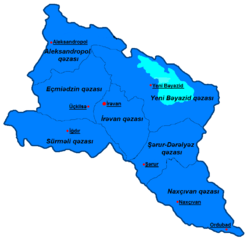- Nakhchivansky Uyezd
-
Nakhchivansky Uyezd (English)
Нахичеванский уезд (Modern Russian)
Coat of Arms 
Coat of arms of Erivan GovernorateEstablished 1849 Abolished 1920 Political status
RegionUyezd
CaucasusArea Area
- Rank3,858.8 verst²
n/aPopulation (1897 census) Population
- Rank
- Density
- Urban
- Rural100,771 inhabitants
n/a
26.1 inhab. / verst²
Government First Head
Last Headn/a
n/a Map of Erivan Governorate with seven uyezds. Nakhchivansky Uyezd is the most southern uyezd
Map of Erivan Governorate with seven uyezds. Nakhchivansky Uyezd is the most southern uyezd
Nakhchivansky Uyezd (Russian: Нахичеванский уезд) was one of the uyezds (administrative units) of Erivan Governorate of the Russian Empire with its center in Nakhchivan from 1849 until its formal abolition in 1920 upon Bolshevik takeover of Azerbaijan.[1]
Contents
Geography
Erivan Governorate consisted of Erivansky, Alexandropolsky, Echmiadzinsky, Nakhchivansky, Novobayazetsky, Surmalinsky, and Sharur-Daralagozsky uyezds.[2] Nakhchivansky Uyezd was located in the southern part of Erivan Governorate bordering its Sharur-Daralagozsky Uyezd in the north, Zangezursky Uyezd of Elisabethpol Governorate in the east, and Persian and Ottoman empires in the south and west at various times throughout its existence. The area of the uyezd was 3,858.8 versts (4.1166 km2). The relief of the uyezd was mainly mountainous with most of the lowland located along Araz River. The highest peaks of the uyezd were located close to the border with Elisabethpol Governorate along the Karabakh Mountain range (Kambil (Azerbaijani: Kəmbil) at 11,188 ft (3,410 m); Damara-dag (Azerbaijani: Dəmara-dağ at 11,090 ft); Mount Kapudzhukh (Azerbaijani: Qapıcıq) at 12,855 ft) which make up the eastern boundary of the uyezd, and the Kyuki-dag (Azerbaijani: Küki-dağ at 10,282 ft) rising from Daralagoz area on the north. Left tributaries of Araz, Nakhchivan-chay(Azerbaijani: Naxçıvançay), Alinja-chay (Azerbaijani: Əlincəçay), Gilan-chay (Azerbaijani: Gilançay) flowed through the territory of Nakhchivansky Uyezd.[3]
History
The territory of the uyezd had been a part of Erivan and Nakhchivan khanates until 1828, when according to Treaty of Turkmenchay, it was annexed to Russian Empire. In 1849, Erivan Governorate made up of Erivansky, Nakhchivansky, Alexandropolsky, Novobayazetsky and Ordubadsky uyezds was established. Ordubadsky uyezd was abolished and incorporated into Nakhchivansky uyezd and Zangezurskiy Uyezd of Erivan Governorate in 1868. Following administrative reforms of 1870, the northern part of Nakhchivansky Uyezd was separated to form a new Sharur-Daralagozsky Uyezd.[2][4] In 1918, the uyezd became part of Azerbaijan Democratic Republic but was disputed by Democratic Republic of Armenia. With withdrawal of Ottoman forces from Nakhchivan as per Armistice of Mudros, Republic of Aras was proclaimed by Jafar Kuli Khan Nakhchivanski. Due to Armenian-Azerbaijani disputes, Armenian troops invaded Nakhchivan in June 1919 and by July they were repelled by the Azerbaijani army.[5] After establishment of Soviet rule in 1920, the territories of the uyezd became part of Nakhchivan exclave of Azerbaijan SSR.[4]
Population
According to census held in 1897, the population of uyezd was 100,771, of which 64,151 were Azerbaijani Turks, 34,672 were Armenians, 639 - Kurds, 1,014 - Russians and other minorities.[6] Azerbaijani Turks made up the majority of the uyezd, including the major cities of Nakhchivan (70.1%) and Ordubad (88.7%).[7] The population of uyezd was engaged in cattlebreeding and gardening, especially in Ordubad area. There were almost no plants or factories. Salt plantations produced about 250 thousand lbs of salt per annum.[3]
References
- ^ Chisholm, Hugh (1910). The Encyclopædia britannica: a dictionary of arts, sciences, literature and general information. Volume 9. Leiden, the Netherlands: The Encyclopædia Britannica Company. p. 748. ISBN 978-90-04-17901-1. http://books.google.com/books?id=t_0tAAAAIAAJ&pg=PA280&dq=Jevanshir&hl=en&ei=Grc5TcqzLIL6lwfkuuDpBQ&sa=X&oi=book_result&ct=result&resnum=10&ved=0CEoQ6AEwCQ#v=onepage&q&f=false. Retrieved 2011-08-16.
- ^ a b "Административно-территориальные реформы на Кавказе в середине и во второй половине ХIХ века [Administrative-territorial reforms in Caucasus in middle and second half of 19th century]". http://www.rusfs.narod.ru/int02/tislis/tifl1_1.htm. Retrieved 2011-08-16.
- ^ a b "Большой энциклопедический словарь Брокгауза и Ефрона. Нахичевань [Brockhaus and Efron Encyclopedia Dictionary. Nakhchivan]". http://gatchina3000.ru/big/070/70821_brockhaus-efron.htm. Retrieved 2011-08-16.
- ^ a b "Нахичеванская автономная республика [Nakhichavn Autonomous Republic]". http://www.heraldicum.ru/azerbaij/nahicevan.htm. Retrieved 2011-08-16.
- ^ "Official site of Nakhchivan AR. THE HISTORY". http://www.nakhchivan.az/portal-en/tarix.htm. Retrieved 2011-0816.
- ^ "[First All Russian Imperial Census of 1897. Population split according to languages spoken; uyezds of Russian empire except for governorates in European part of empire]". http://demoscope.ru/weekly/ssp/emp_lan_97_uezd.php?reg=575. Retrieved 2011-08-16.
- ^ "НАХИЧЕВАНСКИЙ УЕЗД (1897 г.) [Nakhchivansky Uyezd (1897)]". http://www.ethno-kavkaz.narod.ru/naxichevan1897.html. Retrieved 2011-08-16.
Categories:- History of Azerbaijan
- States and territories established in 1849
- 1920 disestablishments
Wikimedia Foundation. 2010.
